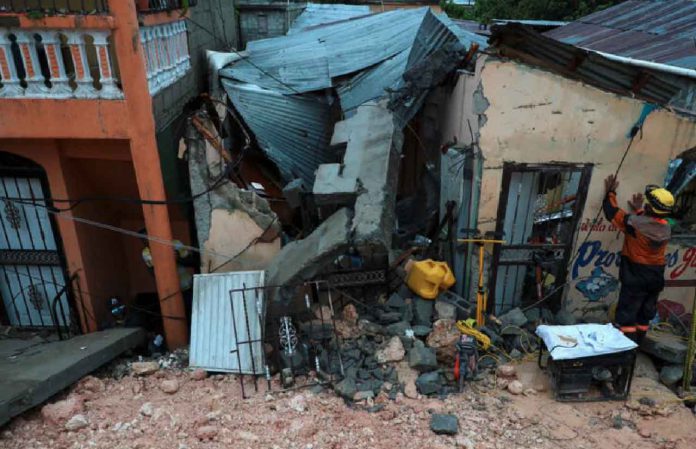
At least 10 people have already died in the storms
By Jennifer Hiller and Ernest Scheyder
HOUSTON (Reuters) – Hurricane Marco and Tropical Storm Laura tore through the Caribbean and Gulf of Mexico on Sunday, forcing thousands of coastal residents in Louisiana and Cuba to flee, and flooding roads in Haiti’s capital, with damage across the region expected to worsen this week.
Marco, which strengthened into a hurricane on Sunday with sustained winds of 75 mph (120 kph), is forecast to make landfall along the Louisiana coast on Monday.
Laura, which hit the Dominican Republic and Haiti earlier on Sunday, killing at least 10 people before striking Cuba on Sunday evening, is forecast to strengthen into a hurricane before making landfall in Texas or Louisiana on Thursday.
U.S. President Donald Trump issued a disaster declaration on Sunday for Louisiana. He had previously issued a similar declaration for Puerto Rico.
In New Orleans, Billy Wright spent his Sunday buying bottled water, non-perishable food and an attic ax, which can be used to chop through a roof if floodwaters block doors and windows. The 33-year-old attorney lives with his fiancee in a one-story house just blocks from a canal that failed during 2005’s Hurricane Katrina.
“You’d rather have it and not need it than be stuck in your attic with rising floodwaters,” said Wright. “Getting two storms back to back is a big concern.”
Louisiana Governor John Bel Edwards warned that tropical storm-force winds would arrive by Monday and told residents that if they did not leave by Sunday night they should be prepared to ride out both Marco and Laura.
Laura could strengthen into a Category 2 or 3 hurricane on the 5-step Saffir-Simpson scale for measuring hurricane intensity and move west, closer to Houston, said Chris Kerr, a meteorologist at DTN, an energy, agriculture and weather data provider.
Category 2 storms have sustained winds of at least 96 mph (155 kph). The threshold for Category 3 storms is 111 mph (178 kph).
In the Dominican Republic, at least three people died, including a mother and her 7-year-old son, due to collapsing walls. Laura knocked out power to more than a million people in that country, forced more than a thousand others to evacuate and collapsed several homes along the Isabela River, authorities said.
In Port-au-Prince people wading waist-deep in muddy water in some of the worst flooding the Haitian capital has seen in years.
Haitian authorities reported seven deaths, including at least two people swept away in flooding and a ten-year old girl crushed when a tree fell on her home. Coastal neighborhoods of the capital were strewn with debris.
Laura hit eastern Cuba on Sunday evening with sustained winds of 60mph (95 kmph) downing trees and ripping flimsy roofing from buildings as it began a forecast 24-hour-treck from east to west along the southern coast of the largest island of the Caribbean.
The Cuban government said power was cut in the easternmost province of Guantanamo and would be shut down province by province as winds picked up across the country as a preventive measure.
Officials and residents, already exhausted by a six-month battle with the coronavirus pandemic and the severe scarcity it has brought, scrambled as Laura bore down to evacuate thousands along the coast and in inland areas vulnerable to flooding.
LOUISIANA, TEXAS BRACE
Back-to-back hurricanes hitting the U.S. coast within days could result in a prolonged period of hazardous weather, the National Hurricane Center said on Sunday.
The Federal Emergency Management Agency has sent teams to operations centers in Louisiana and Texas, spokesman Earl Armstrong said. The agency is prepared to handle back-to-back storms, he said, pointing to 2004 when four hurricanes took aim at Florida in a six-week period.
Officials in Louisiana’s coastal Lafourche Parish ordered residents of low-lying areas to evacuate by noon on Sunday. The U.S. Coast Guard also raised its warning for the Port of New Orleans, calling for ships to make plans to evacuate some areas.
The storms added to worries about the spread of COVID-19. Tulane University, the largest private employer in New Orleans, said it will close its testing center on Monday.
In Grand Isle, at Louisiana’s southern tip, authorities were placing sandbags to bolster its protective levy while energy companies pulled workers from offshore platforms and shut down oil production.
Equinor has finished evacuating its Titan oil-production platform in the U.S. Gulf of Mexico and shut-in oil production at the facility, a spokesman said on Sunday. BHP Group Plc also shut and evacuated its Shenzi and Neptune oil platforms, a spokeswoman said.
Oil producers, including BP Plc, Chevron Corp and Royal Dutch Shell Plc, had shut 58% of the Gulf’s offshore oil production and 45% of natural gas production on Sunday. The region accounts for 17% of total U.S. oil production and 5% of U.S. natural gas output.
(Reporting by Jennifer Hiller, Ernest Scheyder and Gary McWilliams in Houston, Marc Frank and Sarah Marsh in Havana, Andre Paultre in Port-au-Prince, Ezequiel Abiu Lopez in Santo Domingo, Barbara Goldberg in New York and Dan Whitcomb in Los Angeles; Editing by Chizu Nomiyama, Lisa Shumaker and Daniel Wallis)

